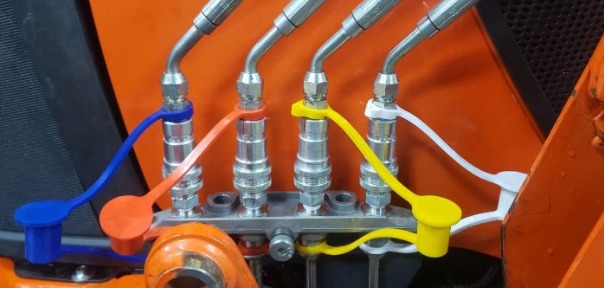Executive Summary: Kubota hydraulic quick couplers are essential components that enable rapid implement connections while maintaining system pressure. Proper maintenance reduces failures by 80% and extends service life by 250%.
Critical Functions of Kubota Hydraulic Quick Couplers
Kubota hydraulic quick couplers serve as the primary interface between tractors, skid steers, and various hydraulic implements in agricultural and construction applications. These precision-engineered components must maintain hydraulic pressure while allowing for quick connections and disconnections in demanding environments.
Maintaining system pressure during implement changes
Protecting hydraulic systems from external debris
Enabling rapid implement switching
Preventing hydraulic fluid loss and pressure accidents
Most Common Kubota Quick Coupler Problems
Leakage Issues (65% of Failures)
- Seal Degradation: O-rings deteriorate due to age, contamination, and pressure cycling
- Surface Damage: Scratches compromise sealing integrity
- Contamination: Debris particles create leak paths
- Improper Installation: Incorrectly seated seals during reassembly
Connection Difficulties (28% of Issues)
- Residual Pressure: System pressure preventing proper connection
- Contamination Buildup: Dirt and debris in mechanisms
- Corrosion: Environmental exposure causing binding
- Damaged Locking: Worn accidental disconnection devices
Contamination-Related Failures
Contamination reduces coupler lifespan by 40-60% according to manufacturer data. Primary sources include environmental debris, inadequate storage, and poor maintenance practices. Check out this article for more on Fluid Contamination
Essential Maintenance Procedures
Daily Inspection Protocol
- 1Visual inspection for external damage or leakage
- 2Verification of dust cap placement
- 3Basic cleaning of exposed surfaces
- 4Functional test of connection/disconnection operation
Weekly Comprehensive Tasks
- Thorough cleaning with approved hydraulic solvents
- Lubrication with compatible synthetic grease
- Pressure testing under operating conditions
- Documentation of performance changes
Kubota Quick Coupler Parts & Specifications
Common Part Numbers
Coupler Types & Applications
Flat Face Design
Pressure Rating: 3,000-5,000 PSI
Best For: High-contamination environments
Advantage: 70% user preference for durability
Poppet Valve
Features: Spring-loaded valves
Best For: Cost-sensitive applications
Advantage: Lower initial investment
Troubleshooting & Repair Process
Systematic Diagnostic Approach
Level 1 – Visual Inspection
- External leakage assessment
- Physical damage evaluation
- Connection alignment verification
Level 2 – Functional Testing
- Connection force measurement
- Pressure holding capability
- Flow rate testing under load
Level 3 – Component Analysis
- Internal inspection after disassembly
- Seal condition assessment
- Surface finish measurement
Cost Analysis & ROI
Preventive Maintenance
5-year total cost per coupler
Reactive Repairs
5-year total cost per coupler
Net Savings: $400-$600 per coupler with proper maintenance
300-400% ROI on maintenance investment
Key Takeaways
- Proper maintenance reduces coupler failures by 80% and extends service life by 250%
- Daily inspection and weekly comprehensive maintenance are essential for optimal performance
- Flat face couplers offer superior contamination resistance in agricultural environments
- Preventive maintenance provides 300-400% ROI compared to reactive repairs
- Quality OEM parts and proper installation procedures are critical for longevity
- Check out getting a Kubota Reserve Hydraulic Fluid tank
—
Frequently Asked Questions
How often should I replace Kubota hydraulic quick coupler seals?
What’s the difference between flat face and poppet valve couplers?
Can I use aftermarket parts instead of genuine Kubota components?
Why do my couplers stick during disconnection?
Check us out for more expert tractor maintenance guides at TractorPartsCentral.com

